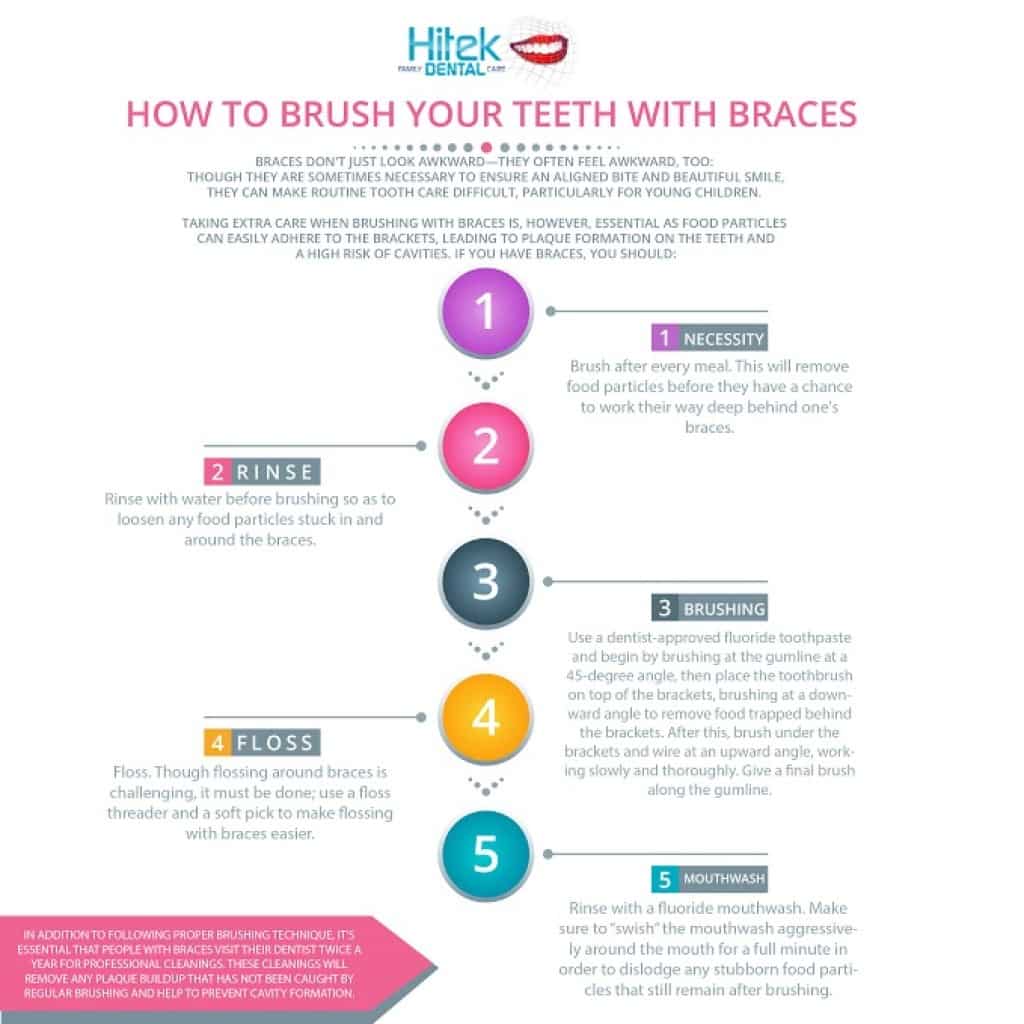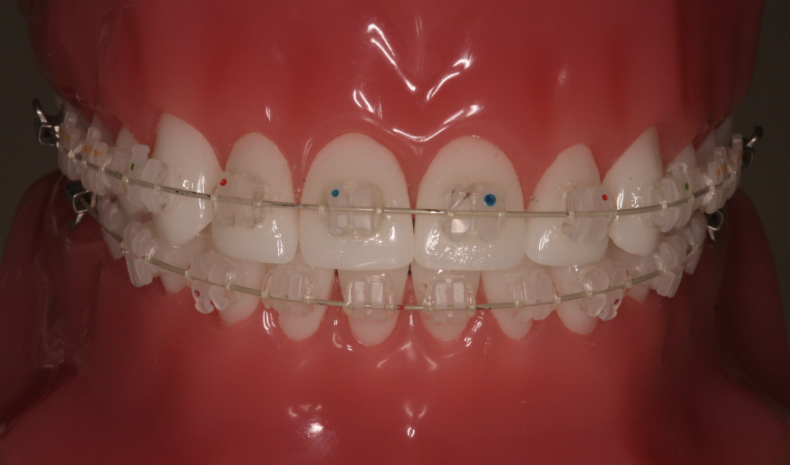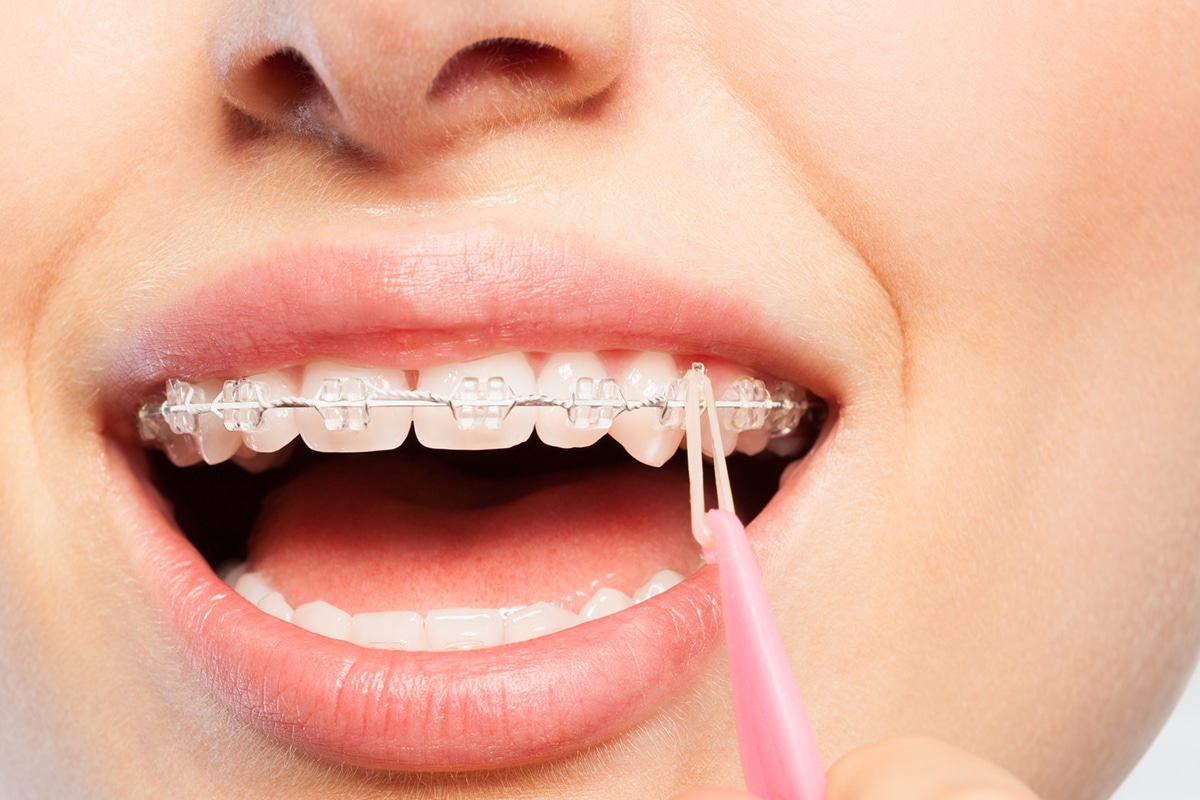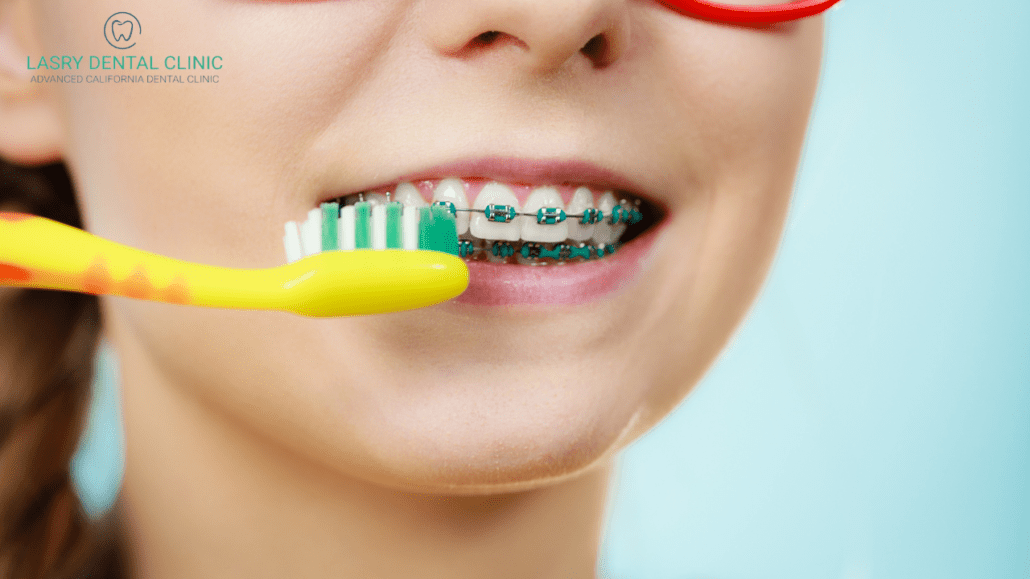Brushing Technique Modifications for Braces

Maintaining optimal oral hygiene with braces requires a modified approach to brushing. Traditional brushing techniques may not effectively reach all areas, leading to plaque buildup and potential dental issues. This section details crucial adjustments to your brushing routine to ensure thorough cleaning around brackets and wires.
Proper brushing technique for braces involves meticulous attention to detail and the use of specialized tools. This ensures a thorough removal of food particles and plaque, minimizing the risk of cavities and gum disease.
Brushing Technique for Braces
Thorough cleaning around brackets and wires is essential for effective plaque removal. The angle of the toothbrush plays a significant role in this process. Positioning the brush at a 45-degree angle towards the gumline and gently moving it back and forth in short, gentle strokes is crucial. This approach ensures that the bristles effectively reach the gumline and clean the areas surrounding the brackets and wires, preventing food particles from accumulating.
Using Interdental Brushes and Floss Threaders
Interdental brushes and floss threaders are vital tools for cleaning spaces between teeth and beneath wires that traditional brushing may miss. These tools provide targeted access to hard-to-reach areas. Interdental brushes are small brushes designed to fit between teeth, effectively cleaning the spaces and preventing plaque buildup. Floss threaders are thin, flexible tools that allow for easier maneuvering around brackets and wires, ensuring thorough cleaning of the area under the wires.
Comparing Manual and Electric Toothbrushes
The choice between manual and electric toothbrushes depends on individual preferences and comfort levels. Both can be effective with proper technique.
| Feature | Manual Toothbrush | Electric Toothbrush |
|---|---|---|
| Cleaning Efficiency | Relies on user technique; can be less efficient for thorough cleaning around braces | Typically more efficient at removing plaque, especially in hard-to-reach areas. |
| Effort Required | Requires more effort and dexterity from the user. | Reduces the physical effort required for brushing. |
| Cost | Generally more affordable | More expensive initially |
| Suitability for Braces | Suitable if proper technique is followed. | Can be highly effective, especially for individuals who find manual brushing challenging. |
Step-by-Step Brushing Guide with Braces
This step-by-step guide demonstrates the proper brushing technique for individuals with braces.
- Gently place the toothbrush at a 45-degree angle against the gumline, close to the bracket. (Diagram: Image shows a toothbrush angled against the gumline near a bracket.)
- Use short, gentle back-and-forth strokes to clean the area around the bracket and the gumline. (Diagram: Image shows the toothbrush moving in short, back-and-forth strokes.)
- Carefully clean the inner and outer surfaces of each tooth. (Diagram: Image shows brushing the inner and outer surfaces of the teeth.)
- Use interdental brushes to clean between teeth and under wires. (Diagram: Image shows using an interdental brush to clean between teeth.)
- Use floss threaders to clean beneath wires and around brackets. (Diagram: Image shows using a floss threader to clean beneath wires.)
- Pay extra attention to areas where food particles or plaque may accumulate. (Diagram: Image highlights areas prone to plaque buildup.)
- Rinse your mouth thoroughly with water. (Diagram: Image shows rinsing the mouth with water.)
Tips for Comfortable and Efficient Brushing
Following these tips can make brushing with braces more comfortable and efficient:
- Use a soft-bristled toothbrush to prevent gum irritation.
- Brush for at least two minutes, twice a day. Consistent brushing is key to maintaining oral hygiene.
- Use fluoride toothpaste to strengthen enamel and prevent cavities.
- Consider using a fluoride mouthwash for additional protection.
- Schedule regular dental checkups and cleanings to monitor the health of your teeth and gums and to address any issues.
Frequency and Duration of Brushing

Maintaining optimal oral hygiene with braces requires a slightly adjusted approach to brushing. A diligent brushing routine is crucial for preventing plaque buildup and cavities, which can be exacerbated by the presence of braces.
Understanding the ideal frequency and duration of brushing, and the importance of post-meal brushing, will contribute to a healthier smile.
Optimal Frequency and Duration
Brushing twice daily, for a duration of two minutes each time, is generally recommended for maintaining good oral health. This consistent timeframe ensures that all tooth surfaces, including those around the brackets and wires, receive adequate attention. A thorough two-minute routine, focusing on all areas, is more effective than a rushed, shorter session.
Importance of Post-Meal Brushing
Brushing after each meal or snack is vital for brace wearers. Food particles and sugary drinks, if left unremoved, provide an ideal environment for bacteria to thrive. This bacterial buildup can lead to plaque accumulation, especially around brackets and wires. Removing these particles immediately after consumption minimizes the risk of plaque formation and subsequent dental issues.
Additional Brushing Sessions
Incorporating additional brushing sessions, particularly after sugary treats or acidic foods, can provide an extra layer of oral hygiene. These extra sessions aid in preventing the rapid accumulation of bacteria, keeping the mouth cleaner and healthier. This proactive approach significantly reduces the risk of cavities and other oral problems associated with brace wear.
Consistency in Maintaining Good Oral Hygiene
Consistency is paramount in maintaining good oral hygiene, especially with braces. A regular and diligent routine, followed consistently, forms the foundation of a healthy smile. Irregular brushing can lead to a buildup of plaque, potentially resulting in issues like gingivitis or cavities, and potentially impacting the overall treatment outcome. A consistent routine is key for successful brace treatment and long-term oral health.
Daily Brushing Schedule
This schedule provides a template for a daily brushing routine. Adjust it to your specific needs and lifestyle, but consistency is key.
| Time | Activity |
|---|---|
| Morning (after breakfast) | Two-minute thorough brushing session. |
| Evening (after dinner) | Two-minute thorough brushing session. |
| After sugary snacks/treats | A quick brushing session. |
Dietary Considerations

Maintaining optimal oral health with braces necessitates careful attention to dietary choices. The presence of braces creates unique challenges for food removal, increasing the risk of plaque buildup and potential dental issues. A balanced and mindful approach to eating is crucial for maintaining a healthy smile during orthodontic treatment.
Impact of Diet on Oral Health with Braces
Diet significantly impacts oral health, particularly when wearing braces. Foods high in sugar and carbohydrates contribute to the growth of bacteria that produce acids, leading to tooth decay. Sticky or hard foods can dislodge or damage brackets and wires, hindering treatment progress and potentially requiring adjustments or repairs. Furthermore, poor dietary choices can lead to increased plaque accumulation, which can result in gum inflammation and potentially more severe oral health problems.
Foods Challenging to Clean Around Braces
Certain foods are more difficult to clean around braces, increasing the risk of food particles becoming trapped. Sticky foods, such as caramel, gummies, and taffy, can cling to brackets and wires, making thorough cleaning challenging. Hard foods, like nuts, hard candies, and popcorn kernels, can damage brackets and wires. The presence of these foods in the diet during orthodontic treatment should be minimized.
Minimizing the Impact of Challenging Foods
To minimize the negative impact of challenging foods, opt for alternative options. For instance, instead of sticky candies, choose fruits or vegetables as a snack. If you crave hard foods, choose softer alternatives or simply avoid them entirely during treatment. Taking smaller bites and chewing slowly can also help reduce the risk of food particles becoming trapped around braces.
Importance of Avoiding Sticky or Hard Foods
Avoiding sticky or hard foods is paramount for maintaining the integrity of braces and accelerating treatment success. These foods can dislodge or damage brackets and wires, necessitating costly and time-consuming repairs. Avoiding these foods helps prevent potential setbacks and ensures that treatment proceeds as planned. Prioritizing a diet that supports the orthodontic process is essential.
Brace-Friendly Foods
A diet rich in brace-friendly foods can significantly support oral hygiene and maintain healthy teeth and gums. Fruits and vegetables, particularly those with a crunchy texture, encourage saliva production, helping to wash away food particles. Lean proteins, such as chicken and fish, contribute to a healthy diet without posing a significant risk to braces. Soft, easily digestible foods, such as soups and yogurt, are also ideal choices.
Table of Foods to Avoid
| Food Category | Specific Foods | Reason for Avoidance |
|---|---|---|
| Sticky Foods | Caramel, gummies, taffy, chewing gum | Can cling to brackets and wires, making cleaning difficult and increasing plaque buildup. |
| Hard Foods | Nuts, hard candies, popcorn kernels, ice | Can damage brackets and wires, leading to potential repairs and delays in treatment. |
| Sugary Drinks | Soda, sugary juices | Contribute to tooth decay and increase the risk of plaque buildup. |
Post-Brushing Care

Proper post-brushing care is crucial for maintaining oral hygiene and preventing complications associated with braces. A thorough rinse and smart use of mouthwash can significantly improve the effectiveness of your brushing routine. This section will explore the importance of rinsing, the role of mouthwash, strategies for managing discomfort, and proactive measures to address common oral hygiene concerns specific to braces.
Thorough Rinsing
Thorough rinsing after brushing removes any remaining food particles, plaque, and toothpaste from the mouth. This step is essential for preventing the buildup of bacteria and maintaining a clean oral environment. Proper rinsing also aids in the removal of loose debris that can get trapped around brackets and wires, reducing the risk of cavities and gingivitis.
Mouthwash Use
Mouthwash can enhance the effectiveness of brushing by targeting areas difficult to reach with a toothbrush. Antiseptic mouthwashes contain active ingredients that kill bacteria and help to prevent the formation of plaque and gingivitis. A mouthwash can also help to freshen breath. Some mouthwashes can be especially beneficial for brace wearers due to their ability to clean areas around brackets and wires.
Managing Discomfort
Some mild discomfort or soreness is common after brushing, especially when adjusting to braces. This can be caused by the friction between the braces and the gums or cheeks. Rinsing with a mild salt water solution can help alleviate this discomfort. Over-the-counter pain relievers, such as ibuprofen or acetaminophen, may also provide temporary relief. If the discomfort persists or worsens, consult a dentist or orthodontist.
Preventing and Treating Oral Hygiene Issues, How to brush teeth with braces
Several oral hygiene issues are more prevalent in brace wearers. Regular brushing, flossing, and rinsing can help mitigate these concerns. Regular dental checkups are vital to identify and address any issues early. Proper flossing techniques are essential to clean between brackets and wires, preventing plaque buildup and maintaining optimal oral health. If you experience bleeding gums, consult a dentist or orthodontist for appropriate treatment.
Cleaning Braces
Maintaining the cleanliness of the braces themselves is an important aspect of oral hygiene. Regular brushing and rinsing, along with proper flossing techniques, can help prevent food particles and plaque from accumulating on the brackets and wires. Interdental brushes or floss threaders can be very helpful for reaching hard-to-reach areas around brackets and wires. Use a soft-bristled toothbrush and a gentle, scrubbing motion to clean the braces without causing damage.
FAQ Guide: How To Brush Teeth With Braces
How to brush teeth with braces – How often should I brush my teeth with braces?
Brush your teeth at least twice a day, ideally after every meal or snack, to remove food particles and plaque.
What type of toothbrush is best for braces?
Soft-bristled toothbrushes, manual or electric, are suitable. Electric toothbrushes can be more effective at removing plaque, but manual toothbrushes are still a viable option.
What tools can help me clean between teeth with braces?
Interdental brushes and floss threaders are essential for cleaning between teeth and under wires. Choose the tool that best suits your needs and comfort.
What foods should I avoid while wearing braces?
Avoid sticky or hard foods that can damage braces or be difficult to remove, such as caramel, taffy, hard candies, and popcorn kernels.